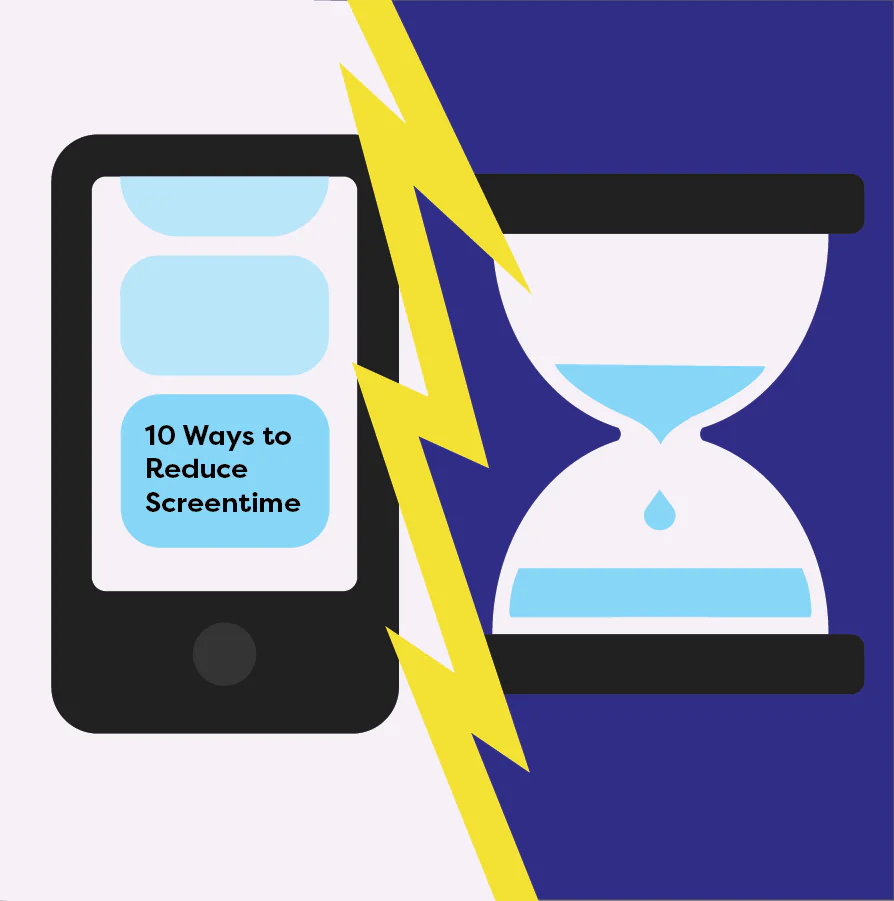10 Ways to Reduce Screen Time

According to the American Academy of Pediatrics, the recommended amount of screen time is as follows: no screen time for children under two, one hour a day for children two to twelve, and two hours a day for teens and adults. I definitely exceed the recommended time for adults by a lot. I don’t know if you’ll believe me, but I’m staring at a screen right now.
Actually, that’s very believable; I literally have to look at a screen to write this.
And you have to look at a screen to read this.
Okay, what I’m trying to say in a roundabout way is that screens have become integral to our daily lives.
Even though it feels like a necessary evil as an adult, it can be incredibly harmful to developing minds. But don’t take my word for it. Pediatrician, parent, and researcher Dimitri Christakis explored what the stimulation from media does to a child:
[it’s the] overstimulation hypothesis, which is that prolonged exposure to this rapid image change during this critical window of brain development would precondition the mind to expect high levels of input, and that would lead to inattention in later life…as a school-age child [reality is] boring; it’s too slow…Why do I have to walk from here to there? That’s the general idea that you’re conditioning the mind to that reality which doesn’t actually exist. (6:39-7:18, TEDxRainier - Dimitri Christakis - Media and Children)
He continued to share an uncomfortable result from putting the “overstimulation hypothesis” to the test. The more television a child watches before the age of 3, the more they’re at risk of having attention issues when they enter school. For each hour they watch a day before age 3, their chance of problems with attention later in life increases by 10%. If they watch an average of 2 hours a day, they’re 20% more likely to have attention problems (Christakis).
I recommend watching his whole TedTalk. He explores more of his scientific research, which is incredibly eye-opening. You can tell it’s really scientific; he experimented with mice and everything. Nothing’s ever really scientific till there’s a mouse experiment. Everyone knows that.
So, we established why it’s so important to limit screen time for younger children. As they grow into middle school and high school, the issues don’t end but shift. Too much time in front of the screen can translate to too little sleep and unhealthy weight gain. When they’re streaming, playing video games, or on social media, what is the screen replacing? Are they missing out on learning from real-life experiences? Exercise? Connections with friends?
It’s easy to point out the problem, but it’s a whole other thing to take the actual steps to address the issue. I’ve scoured the internet for different tips to reduce screen time in the household, and I want to share some of my favorites.
-
Put the screen in a shared environment.
Leaving the screens out in the open won’t only make it easier to limit screen time, but it’ll make it easier to have some control over what kind of content your child chooses to watch.
-
Set goals, but be realistic
Going cold turkey is hard for anyone, no matter the age. So, if the recommended hour is a far cry from your child’s present reality, do small attainable goals. Plus, there are particular environments where screens are your best friends, like long plane rides. Be consistent but bending every so often is not the end of the world.
-
Don’t eat and watch
This tip is hard. When I think of watching something, I think of snacking. When I’m snacking, I think of watching something. It’s a vicious cycle. A very unhealthy vicious cycle of overeating.
-
Establish phone-free zones/times
Be clear that there are certain times and places that are phone and tablet free. Choose a time when it’s essential to have a face-to-face connection, like at the kitchen table during dinner, on family game night, or an hour before bedtime.
-
Limit your screen time
I know. I felt personally attacked when I read that nugget of advice. It’s like the old saying, monkey see monkey do. If your kids see you spending most of your time on your phone or laptop, why would they do any different?
-
Make them part of the decision-making process.
Okay. So, you limit your child’s time on screens. When are they allowed their screen time? Let them choose! Maybe it’s right after school? Or maybe as soon as they’re done with homework? When they choose the time, it’s like limiting screen time is a mutual decision and not some form of punishment.
-
When they do have screen time, choose the content wisely.
The amount of screen time isn’t the only decider in whether or not a child is at risk of attention problems. What they watch is just as important. Citing Dr. Christakis again, he states that slower educational programs like Mr. Rogers or Bluey pose no risk of attention problems, entertainment programs with bright and quick scene changes increases the chances by 60%, and violent programs have even more rapid sequencing and
-
List alternatives to screens
Okay, they are no longer attached at the hip to their screens, but now what? Give them alternatives. If they have nothing to do but stare at screens, they’re going to stare at screens. Get art supplies, sports equipment, *cough* a StairSlide *cough*, basically anything that will support or help them explore other hobbies!
-
Limit handheld devices
Handheld devices like iPhones and tablets are usually the most popular perpetrators of excess screen time. It’d be better to avoid handheld devices for your child altogether, but this is sometimes not realistic. When they get older, there are more extracurricular activities which come with more independence, but you might not be comfortable letting them into the world without a way to communicate. Maybe they need a phone if their activity got out early and they need a ride? Or do they want to tell you they found a ride home with a friend? Or even just for a general check-in. There are ways to stay connected while maintaining safe screen time limits.
Get them an Apple Watch instead of an iPhone: they still have the freedom to text their friends, but more importantly, you have peace of mind that there’s a way to check in with them even when they’re away from home. Plus, no one can comfortably scroll through social media or watch Netflix on a 40 mm square, so the chance of spending too much time on it is slim to none.
Look into kid-friendly phones: while these devices vary somewhat, they only include what your child needs and excludes what they don’t–like social media. This family lifestyle site made a great list of some of the most popular options.
-
Explain the ‘why?’ behind the rules
Of course, your child will go to a friend's home, and the friend’s household rules will be different. You will probably hear, “But Timmy’s mom lets him do this and that,” and possibly endure a tantrum. Get ahead of the explosion, and explain why your home has specific rules. It’s easier to follow a rule when you understand the reason behind the rule. You might not be able to altogether avoid an outburst, but it’ll be downgraded to a whine or two.
If you do happen to incorporate some of these steps into your life, remember that limiting screen time is beneficial long-term. Like the wise words of Dr. Dimitri Christakis (yes, again), ”If you change the beginning of the story, you change the whole story.” There will be moments when you’re frustrated and tempted to hand your child an iPad for a nugget of peace, but that one extra hour planted in front of a screen could do unseen damage to their future (save the screens as a last resort).













Leave a comment